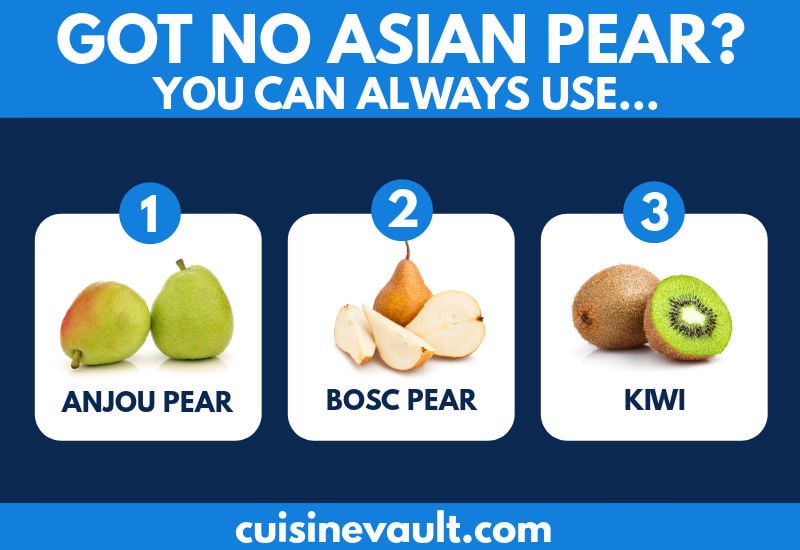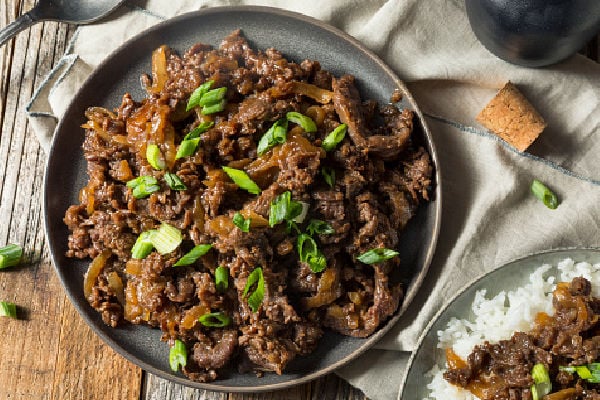Asian pears have a firm, crispy texture similar to an apple, and a grainy consistency a lot like a pear’s. Its flavor is sweet with low levels of acidity and a floral undertone. Many people enjoy this fruit thanks to its high levels of sweet fragrant juice, which is reminiscent of pineapple.
The Asian pear, also known as Korean pear or Nashi pear, is excellent eaten out of hand. With a skin that’s thicker and tougher than an apple, some prefer to peel the fruit before eating, but it isn’t essential. In Korean cuisine, the fruit is used to tenderize meat, making it a useful marinade ingredient. The classic dish bulgogi often calls for the use of Asian pear during the marinating step.
You can find the Asian pear sold at supermarkets, covered in polyethylene fruit socks for protection. However, they aren’t always ranged in-store, and if they’re out of season then their price can climb quite high. Whatever the reason, if you can't get your hands on them, you’ll need an Asian pear substitute. We’ve about to provide some good alternatives to help you finish that recipe.
Table of Contents
 How to replace Asian pears in the kitchen
How to replace Asian pears in the kitchen
1. Anjou pear
For everyday eating out of hand.
The Anjou pear is a deliciously firm-textured fruit that is loaded with juice. There are red and green varieties available but it won’t matter which one you buy as they taste very similar. Although an Asian pear has more juice and a slightly crispier texture, you could easily substitute one for the other. But its the Anjou’s lower price tag that makes it a more appealing fruit to include for a healthy snack.
If you can’t find Anjou pears at the supermarket, try Bartlett. They are another European pear variety with similar characteristics, perfect for slicing up and eating fresh.
2. Bosc pear
For cheese platters and salads.
The Bosc pear is another popular fruit that is sweet, juice-laden and has a floral undertone. It also has a mild taste of fall spices like nutmeg and cinnamon, making it perfect for using in place of Asian pear on a fruit platter. Pair it alongside Blue, Gouda, and Cheddar for a delicious flavor combination.
Asian pear is also great sliced into coleslaw or salad. Like the nashi, it has white flesh so a light splash of lemon juice will stop the fruit turning brown. Dessert and baking recipes that call for Asian pear will also work well with the addition of bosc pear.
3. Kiwi
For meat marinades.
Many Korean recipes for meals like bulgogi use Asian pear to add flavor, but perhaps more importantly, they improve meat texture. To mimic these benefits, you can also use a kiwifruit. Calpain in the fruit acts as a meat tenderizer. The tougher fibers in beef are softened, and squid soaked in milk and kiwifruit is easier to chew.
Be cautious when using kiwis in place of pear, as they can over-tenderize if you leave it too long. We recommend marinating the meat in kiwifruit for half the time that you would if using Asian pear.
It’s worth pointing out that kiwifruit will bring a different flavor to the meat. However, after cooking, the difference is barely noticeable.
4. Soda
For meat marinades.
If you’ve got no Asian pear in the fruit bowl then another great option for marinating meat is soda. Got some coke or sprite in the fridge? Soak your meat in a bath of soda and it’ll soften nicely while adding a subtle sweetness to the marinade.
5. A.1. Classic Marinade
The quick and easy marinade.
Traditional Korean chefs may want to skip past this option. We are rapidly moving away from more authentic homemade marinades. But if you’re short on time, and don’t have any Asian pear in the kitchen, then a bottled product like A.1. or even HP Sauce will work well. This is fusion cooking at its finest! Make a Korean bulgogi dish using a sauce from out of the U.K.
6. Leave out the pear completely
For marinating tender, thin meat slices.
If you’re making bulgogi and you’ve got delicious tender ribeye then tenderizing isn’t necessary. The meat is cut very thinly and if it's quality meat it will melt in your mouth when cooked well. Simply make the marinade without the pear and focus on adding flavor rather than tenderizing.

A plate of Korean bulgogi ready to be eaten.
Related reading:
Need a lingonberry substitute? We've got a whole list of options for you.
What does a Red Anjou pear taste like?
Summing up
Asian pear is a lovely mild fruit with a firm, crisp texture, and lots of juice. Sautéed with pork, processed and added to soup, used as a tenderizing ingredient in marinades, or eaten on its own, this fruit has many uses in food.
The Asian pear isn’t always easy to find and even if it is stocked in your local store, the prices can be expensive. Deciding on the best substitute will depend on what you need it for. Anjou or Bosc pear look and taste similar to Asian pear, making them a good replacement for eating out of hand, adding to salads, desserts, and cheese boards. Either a kiwi or soda will both work well if you need to replace the fruit as a tenderizer in bulgogi or other meat dishes. There will be a slightly different flavor but they won’t taste out of place in the meal.
Of course, you could also leave the Asian pear out of the recipe and not replace it at all. A tender cut of meat will usually taste deliciously tender without the need to marinate for hours. Simply add the other ingredients for flavor, and cook.
Do you have a useful Asian pear substitute that you’d like to share? Please leave a comment below and we’ll give it a try.

Leave a Reply